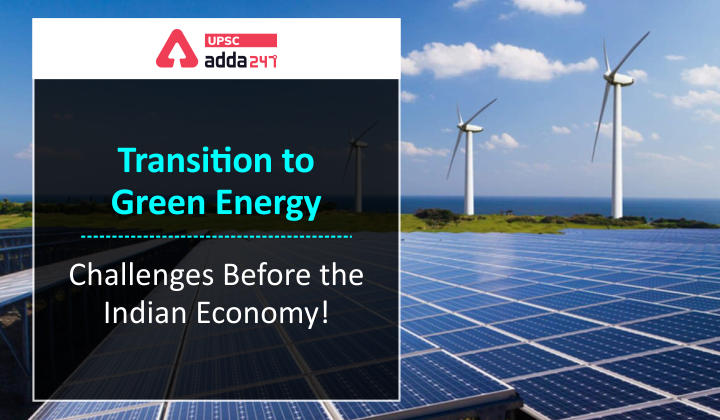G.S. Paper 3: Indian Economy; Environment and Ecology.
Context:
There is a serious concern among the economists of the world that the ongoing worldwide transition to green energy poses a significant risk of triggering energy price shocks similar to the 1970s, which would accelerate inflation.
Background:
India is shining in the energy transition by treading a strong renewable energy path post-2015 Paris Agreement as it witnesses a step-up in investments in solar energy. Additionally, there is a significant slowdown in investments in thermal power plants.
Transition to Green Energy:
- Total installed renewable energy capacity in India, excluding large hydropower, has crossed the milestone of 100 GW or 100,000 MW, about 26 per cent of the total capacity, a turning point in the history of renewables.
- India has gone from 10 GW to 100 GW in just 15 years, from 2005 onwards.
- With the total installed renewable energy capacity reaching 100 GW, India now stands fourth in the world in terms of installed renewable capacity, fifth in solar and fourth in wind in terms of installed capacity.
- Now India has a target of installing 175 GW of wind and solar energy by 2022. If achieved, that would be close to 50 per cent of India’s current total installed power capacity.
- According to Central Electricity Authority (CEA) projections, instead of 40 per cent, India will have 63 per cent of installed capacity from non-fossil fuel sources by 2029-30.
Towards a Green Economy:
- The global surface temperature is already about 1.1 degrees higher today than in the period 1850-1900.
- The accelerated renewable proliferation of India clearly shows that India is the only G20 nation that is on track to achieve Paris commitments.
- India has taken several initiatives, including setting up the International Solar Alliance, for raising the domestic renewable energy target to 450 GW by 2030 and putting in place an ambitious National Hydrogen Mission and continuing efforts to decouple its emissions from economic growth.
- India in its Nationally Determined Contributions (NDCs)committed to three targets, which are to be achieved by the year 2030. First, by 2030, 40% of India’s cumulative electric power installed capacity will come from non-fossil fuel-based energy sources. Second, India will reduce the emission intensity of its gross domestic product (GDP) by 33–35% (vis-à-vis 2005 levels). Third, India will create an additional carbon sink of 2.5–3 billion tonnes of CO2 equivalent (through additional forest and tree cover).
Recent Concerns:
- Thermal Power Plants(TPPs) contributed 71% of the 1,382 billion units (BU) of electricity generated by utilities in India during FY 2020-21 though they accounted for only 55% of the total installed generation capacity of 382 GW (as of March 2021).
- On the other hand, variable renewable energy (VRE) sources (primarily, wind and solar) account for 24.7% of the total installed generation capacity, as of March 2021, they contributed 10.7% of the electricity generated by utilities during FY 2020-21.
- Apart from that, the rapid growth of VRE sources in India has been largely aided by policy measures as well as financial incentives whose ‘’cost is borne by the consumer.’’
- A recent concern is about the ‘’tail risk to global growth’’ as posed by emerging financial sector fragility in China reminiscent of Japan of the late.
- The upside risks to long term inflation and to inflation expectations are now more aggravated.
- Other Concerns: Renewable Purchase Obligations as a Ceiling, Not Floor; Finance for the RE Sector is Not Easy; Policy Uncertainty is Bad for the Economy.
What Should be the way forward:
- India must implement a plan to increase energy efficiency and reduce the emissions of carbon dioxide (CO2) and airborne pollutants from TPPs without making power unaffordable to industries that need low-cost 24×7 power to compete in the global market.
- The resulting shortfall in baseload electricity generation can be made up by increasing the utilisation of existing High-Efficiency-Low-Emission (HELE) TPPs.
- The feat of 100GW of renewable energy is a testimony to India’s desire to adopt sustainable energy choices. However, the road ahead needs further acceleration of these targets to help India decarbonise its energy sector. This can be achieved through advancement in technology and finance across the value chain and also providing a stable and conducive policy environment.”
Conclusion:
In conclusion, there is no doubt that ambitious RE and climate targets have pushed India well on its way to a clean energy future. However, the risk of economic slowdown due to rapid energy transition should also be handled with due care by optimising the use of our land, coal, water, and financial resources with indigenous technology. In fact, India should set an example by developing a carbon-free energy future.



 TSPSC Group 1 Question Paper 2024, Downl...
TSPSC Group 1 Question Paper 2024, Downl...
 TSPSC Group 1 Answer key 2024 Out, Downl...
TSPSC Group 1 Answer key 2024 Out, Downl...
 UPSC Prelims 2024 Question Paper, Downlo...
UPSC Prelims 2024 Question Paper, Downlo...




